Tesco Plc: Business Environment Analysis and Organizational Functions
VerifiedAdded on 2020/10/05
|17
|5914
|173
Report
AI Summary
This report provides a comprehensive analysis of Tesco Plc's business environment. It begins by defining different types of organizations (public, private, and voluntary) and their purposes, followed by an examination of the size and scope of these organizations. The report then explores the relationship between various organizational functions, such as HR, R&D, marketing, finance, operations, and administration, and how they relate to the firm's objectives and structure. Scenario 1 explores these concepts, while Scenario 2 delves into the identification of positive and negative impacts of the macro-environment on business operations. The report also conducts internal and external analyses of the organization, highlighting the interrelation of strengths and weaknesses with external macro factors. The report uses Tesco Plc as a case study to illustrate the concepts.
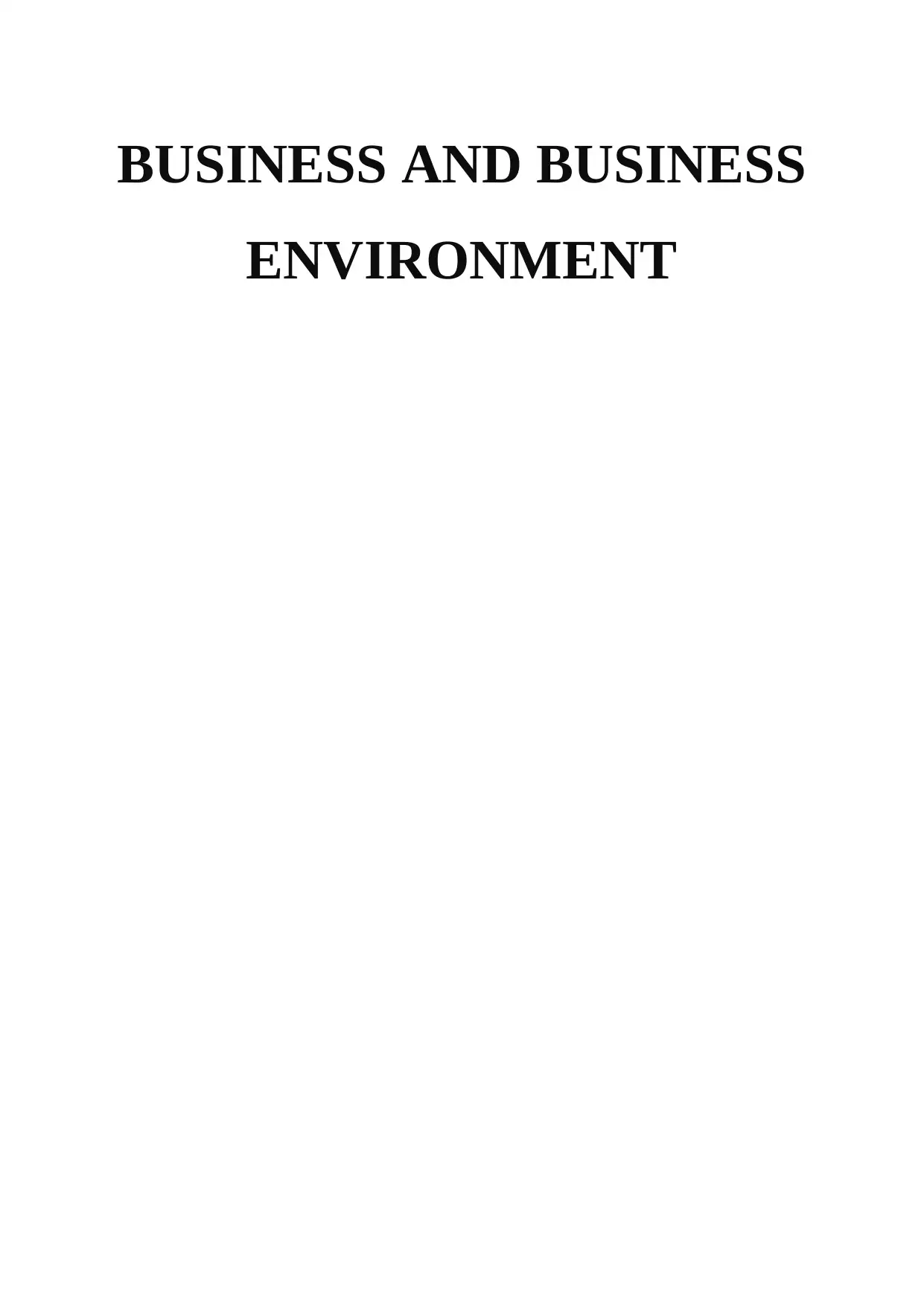
BUSINESS AND BUSINESS
ENVIRONMENT
ENVIRONMENT
Paraphrase This Document
Need a fresh take? Get an instant paraphrase of this document with our AI Paraphraser
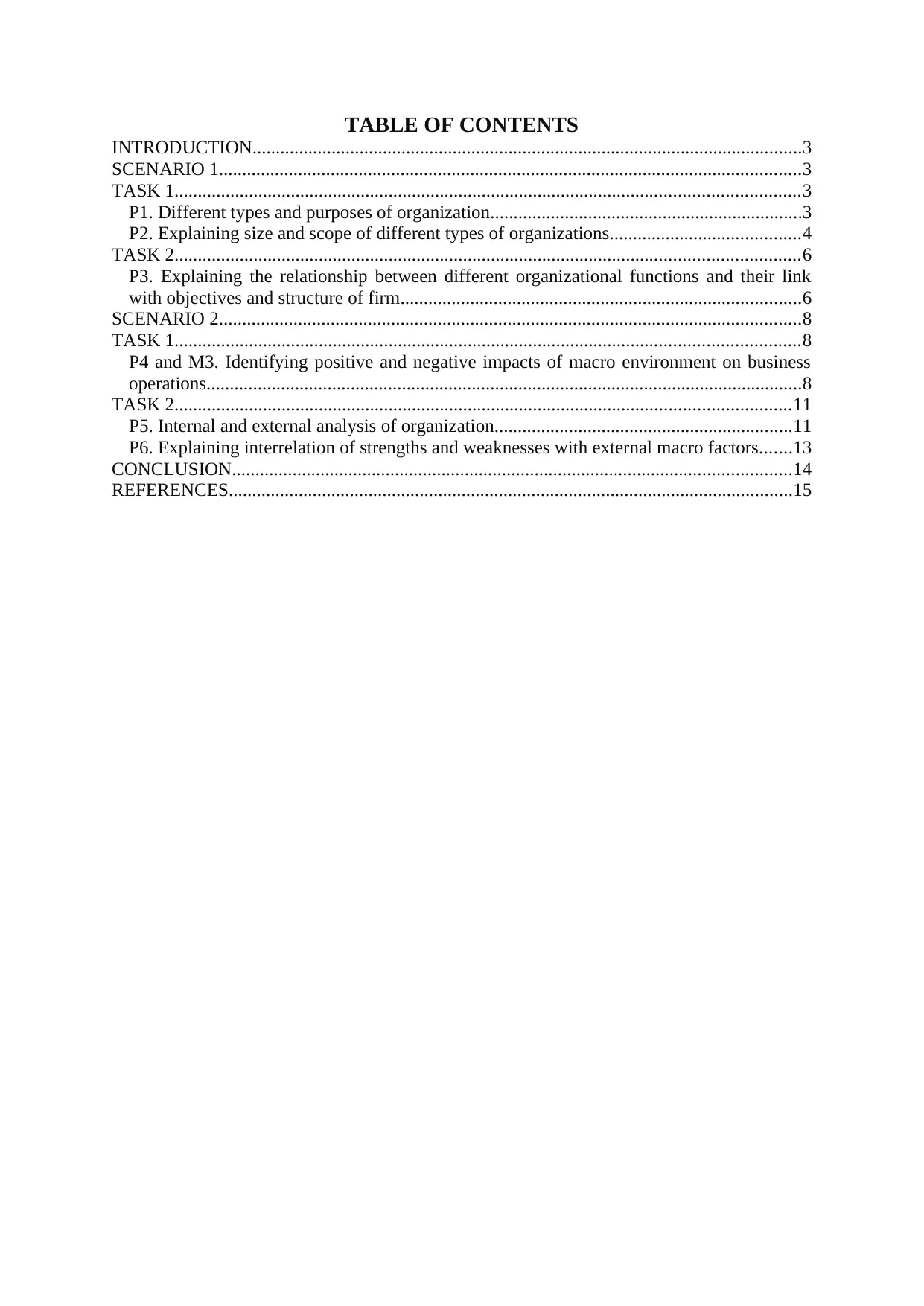
TABLE OF CONTENTS
INTRODUCTION......................................................................................................................3
SCENARIO 1.............................................................................................................................3
TASK 1......................................................................................................................................3
P1. Different types and purposes of organization...................................................................3
P2. Explaining size and scope of different types of organizations.........................................4
TASK 2......................................................................................................................................6
P3. Explaining the relationship between different organizational functions and their link
with objectives and structure of firm......................................................................................6
SCENARIO 2.............................................................................................................................8
TASK 1......................................................................................................................................8
P4 and M3. Identifying positive and negative impacts of macro environment on business
operations................................................................................................................................8
TASK 2....................................................................................................................................11
P5. Internal and external analysis of organization................................................................11
P6. Explaining interrelation of strengths and weaknesses with external macro factors.......13
CONCLUSION........................................................................................................................14
REFERENCES.........................................................................................................................15
INTRODUCTION......................................................................................................................3
SCENARIO 1.............................................................................................................................3
TASK 1......................................................................................................................................3
P1. Different types and purposes of organization...................................................................3
P2. Explaining size and scope of different types of organizations.........................................4
TASK 2......................................................................................................................................6
P3. Explaining the relationship between different organizational functions and their link
with objectives and structure of firm......................................................................................6
SCENARIO 2.............................................................................................................................8
TASK 1......................................................................................................................................8
P4 and M3. Identifying positive and negative impacts of macro environment on business
operations................................................................................................................................8
TASK 2....................................................................................................................................11
P5. Internal and external analysis of organization................................................................11
P6. Explaining interrelation of strengths and weaknesses with external macro factors.......13
CONCLUSION........................................................................................................................14
REFERENCES.........................................................................................................................15
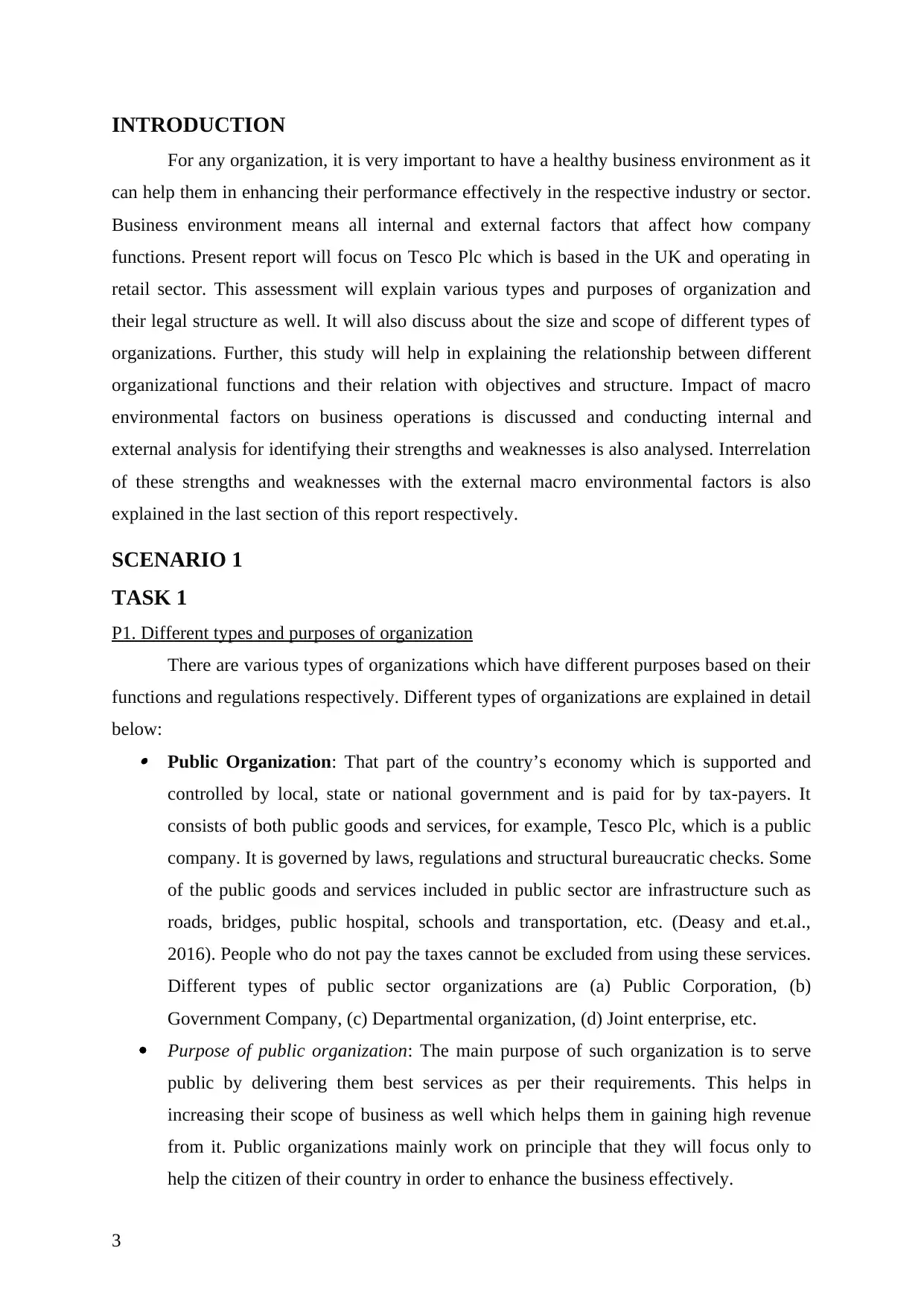
INTRODUCTION
For any organization, it is very important to have a healthy business environment as it
can help them in enhancing their performance effectively in the respective industry or sector.
Business environment means all internal and external factors that affect how company
functions. Present report will focus on Tesco Plc which is based in the UK and operating in
retail sector. This assessment will explain various types and purposes of organization and
their legal structure as well. It will also discuss about the size and scope of different types of
organizations. Further, this study will help in explaining the relationship between different
organizational functions and their relation with objectives and structure. Impact of macro
environmental factors on business operations is discussed and conducting internal and
external analysis for identifying their strengths and weaknesses is also analysed. Interrelation
of these strengths and weaknesses with the external macro environmental factors is also
explained in the last section of this report respectively.
SCENARIO 1
TASK 1
P1. Different types and purposes of organization
There are various types of organizations which have different purposes based on their
functions and regulations respectively. Different types of organizations are explained in detail
below: Public Organization: That part of the country’s economy which is supported and
controlled by local, state or national government and is paid for by tax-payers. It
consists of both public goods and services, for example, Tesco Plc, which is a public
company. It is governed by laws, regulations and structural bureaucratic checks. Some
of the public goods and services included in public sector are infrastructure such as
roads, bridges, public hospital, schools and transportation, etc. (Deasy and et.al.,
2016). People who do not pay the taxes cannot be excluded from using these services.
Different types of public sector organizations are (a) Public Corporation, (b)
Government Company, (c) Departmental organization, (d) Joint enterprise, etc.
Purpose of public organization: The main purpose of such organization is to serve
public by delivering them best services as per their requirements. This helps in
increasing their scope of business as well which helps them in gaining high revenue
from it. Public organizations mainly work on principle that they will focus only to
help the citizen of their country in order to enhance the business effectively.
3
For any organization, it is very important to have a healthy business environment as it
can help them in enhancing their performance effectively in the respective industry or sector.
Business environment means all internal and external factors that affect how company
functions. Present report will focus on Tesco Plc which is based in the UK and operating in
retail sector. This assessment will explain various types and purposes of organization and
their legal structure as well. It will also discuss about the size and scope of different types of
organizations. Further, this study will help in explaining the relationship between different
organizational functions and their relation with objectives and structure. Impact of macro
environmental factors on business operations is discussed and conducting internal and
external analysis for identifying their strengths and weaknesses is also analysed. Interrelation
of these strengths and weaknesses with the external macro environmental factors is also
explained in the last section of this report respectively.
SCENARIO 1
TASK 1
P1. Different types and purposes of organization
There are various types of organizations which have different purposes based on their
functions and regulations respectively. Different types of organizations are explained in detail
below: Public Organization: That part of the country’s economy which is supported and
controlled by local, state or national government and is paid for by tax-payers. It
consists of both public goods and services, for example, Tesco Plc, which is a public
company. It is governed by laws, regulations and structural bureaucratic checks. Some
of the public goods and services included in public sector are infrastructure such as
roads, bridges, public hospital, schools and transportation, etc. (Deasy and et.al.,
2016). People who do not pay the taxes cannot be excluded from using these services.
Different types of public sector organizations are (a) Public Corporation, (b)
Government Company, (c) Departmental organization, (d) Joint enterprise, etc.
Purpose of public organization: The main purpose of such organization is to serve
public by delivering them best services as per their requirements. This helps in
increasing their scope of business as well which helps them in gaining high revenue
from it. Public organizations mainly work on principle that they will focus only to
help the citizen of their country in order to enhance the business effectively.
3
⊘ This is a preview!⊘
Do you want full access?
Subscribe today to unlock all pages.

Trusted by 1+ million students worldwide
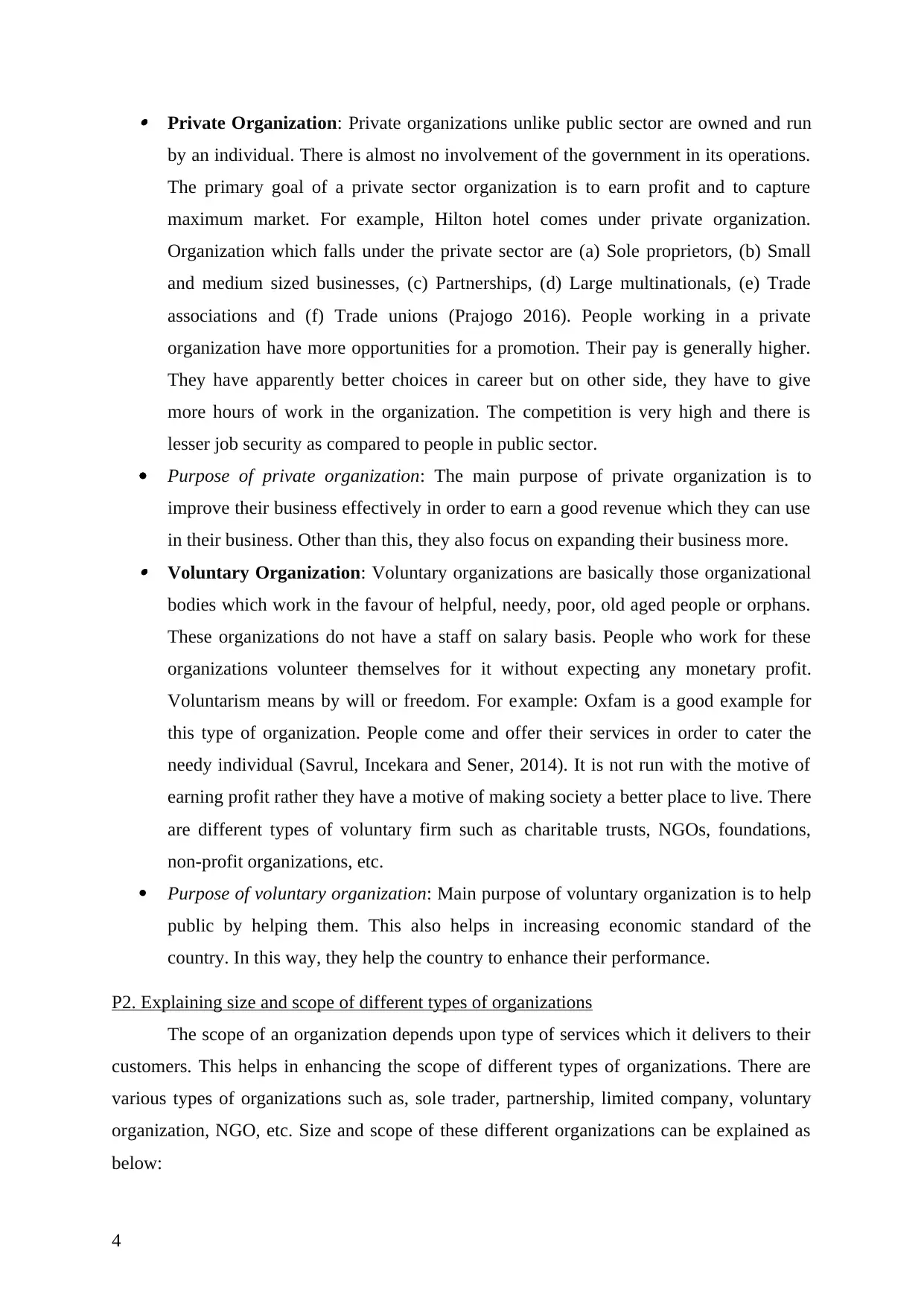
Private Organization: Private organizations unlike public sector are owned and run
by an individual. There is almost no involvement of the government in its operations.
The primary goal of a private sector organization is to earn profit and to capture
maximum market. For example, Hilton hotel comes under private organization.
Organization which falls under the private sector are (a) Sole proprietors, (b) Small
and medium sized businesses, (c) Partnerships, (d) Large multinationals, (e) Trade
associations and (f) Trade unions (Prajogo 2016). People working in a private
organization have more opportunities for a promotion. Their pay is generally higher.
They have apparently better choices in career but on other side, they have to give
more hours of work in the organization. The competition is very high and there is
lesser job security as compared to people in public sector.
Purpose of private organization: The main purpose of private organization is to
improve their business effectively in order to earn a good revenue which they can use
in their business. Other than this, they also focus on expanding their business more. Voluntary Organization: Voluntary organizations are basically those organizational
bodies which work in the favour of helpful, needy, poor, old aged people or orphans.
These organizations do not have a staff on salary basis. People who work for these
organizations volunteer themselves for it without expecting any monetary profit.
Voluntarism means by will or freedom. For example: Oxfam is a good example for
this type of organization. People come and offer their services in order to cater the
needy individual (Savrul, Incekara and Sener, 2014). It is not run with the motive of
earning profit rather they have a motive of making society a better place to live. There
are different types of voluntary firm such as charitable trusts, NGOs, foundations,
non-profit organizations, etc.
Purpose of voluntary organization: Main purpose of voluntary organization is to help
public by helping them. This also helps in increasing economic standard of the
country. In this way, they help the country to enhance their performance.
P2. Explaining size and scope of different types of organizations
The scope of an organization depends upon type of services which it delivers to their
customers. This helps in enhancing the scope of different types of organizations. There are
various types of organizations such as, sole trader, partnership, limited company, voluntary
organization, NGO, etc. Size and scope of these different organizations can be explained as
below:
4
by an individual. There is almost no involvement of the government in its operations.
The primary goal of a private sector organization is to earn profit and to capture
maximum market. For example, Hilton hotel comes under private organization.
Organization which falls under the private sector are (a) Sole proprietors, (b) Small
and medium sized businesses, (c) Partnerships, (d) Large multinationals, (e) Trade
associations and (f) Trade unions (Prajogo 2016). People working in a private
organization have more opportunities for a promotion. Their pay is generally higher.
They have apparently better choices in career but on other side, they have to give
more hours of work in the organization. The competition is very high and there is
lesser job security as compared to people in public sector.
Purpose of private organization: The main purpose of private organization is to
improve their business effectively in order to earn a good revenue which they can use
in their business. Other than this, they also focus on expanding their business more. Voluntary Organization: Voluntary organizations are basically those organizational
bodies which work in the favour of helpful, needy, poor, old aged people or orphans.
These organizations do not have a staff on salary basis. People who work for these
organizations volunteer themselves for it without expecting any monetary profit.
Voluntarism means by will or freedom. For example: Oxfam is a good example for
this type of organization. People come and offer their services in order to cater the
needy individual (Savrul, Incekara and Sener, 2014). It is not run with the motive of
earning profit rather they have a motive of making society a better place to live. There
are different types of voluntary firm such as charitable trusts, NGOs, foundations,
non-profit organizations, etc.
Purpose of voluntary organization: Main purpose of voluntary organization is to help
public by helping them. This also helps in increasing economic standard of the
country. In this way, they help the country to enhance their performance.
P2. Explaining size and scope of different types of organizations
The scope of an organization depends upon type of services which it delivers to their
customers. This helps in enhancing the scope of different types of organizations. There are
various types of organizations such as, sole trader, partnership, limited company, voluntary
organization, NGO, etc. Size and scope of these different organizations can be explained as
below:
4
Paraphrase This Document
Need a fresh take? Get an instant paraphrase of this document with our AI Paraphraser
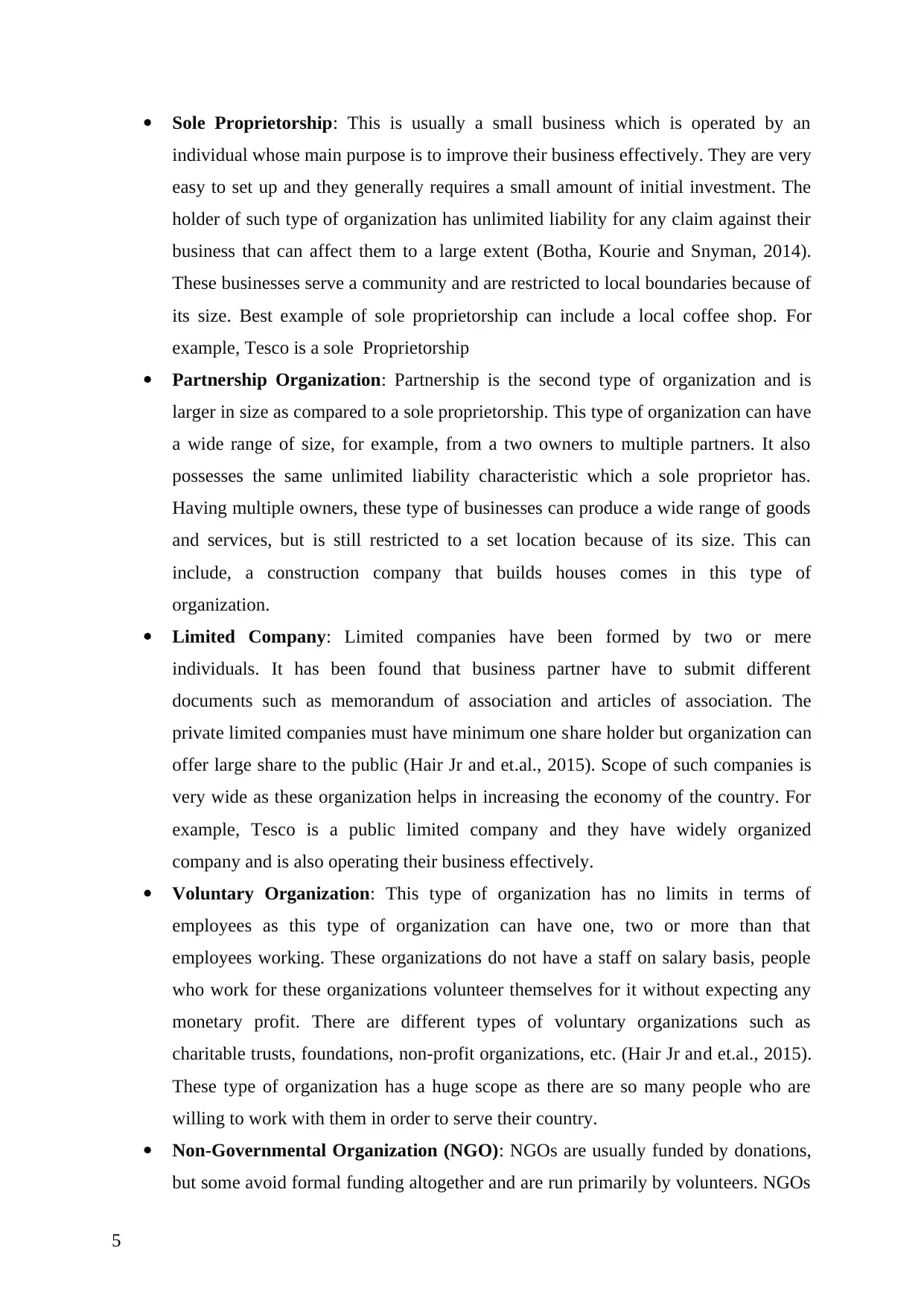
Sole Proprietorship: This is usually a small business which is operated by an
individual whose main purpose is to improve their business effectively. They are very
easy to set up and they generally requires a small amount of initial investment. The
holder of such type of organization has unlimited liability for any claim against their
business that can affect them to a large extent (Botha, Kourie and Snyman, 2014).
These businesses serve a community and are restricted to local boundaries because of
its size. Best example of sole proprietorship can include a local coffee shop. For
example, Tesco is a sole Proprietorship
Partnership Organization: Partnership is the second type of organization and is
larger in size as compared to a sole proprietorship. This type of organization can have
a wide range of size, for example, from a two owners to multiple partners. It also
possesses the same unlimited liability characteristic which a sole proprietor has.
Having multiple owners, these type of businesses can produce a wide range of goods
and services, but is still restricted to a set location because of its size. This can
include, a construction company that builds houses comes in this type of
organization.
Limited Company: Limited companies have been formed by two or mere
individuals. It has been found that business partner have to submit different
documents such as memorandum of association and articles of association. The
private limited companies must have minimum one share holder but organization can
offer large share to the public (Hair Jr and et.al., 2015). Scope of such companies is
very wide as these organization helps in increasing the economy of the country. For
example, Tesco is a public limited company and they have widely organized
company and is also operating their business effectively.
Voluntary Organization: This type of organization has no limits in terms of
employees as this type of organization can have one, two or more than that
employees working. These organizations do not have a staff on salary basis, people
who work for these organizations volunteer themselves for it without expecting any
monetary profit. There are different types of voluntary organizations such as
charitable trusts, foundations, non-profit organizations, etc. (Hair Jr and et.al., 2015).
These type of organization has a huge scope as there are so many people who are
willing to work with them in order to serve their country.
Non-Governmental Organization (NGO): NGOs are usually funded by donations,
but some avoid formal funding altogether and are run primarily by volunteers. NGOs
5
individual whose main purpose is to improve their business effectively. They are very
easy to set up and they generally requires a small amount of initial investment. The
holder of such type of organization has unlimited liability for any claim against their
business that can affect them to a large extent (Botha, Kourie and Snyman, 2014).
These businesses serve a community and are restricted to local boundaries because of
its size. Best example of sole proprietorship can include a local coffee shop. For
example, Tesco is a sole Proprietorship
Partnership Organization: Partnership is the second type of organization and is
larger in size as compared to a sole proprietorship. This type of organization can have
a wide range of size, for example, from a two owners to multiple partners. It also
possesses the same unlimited liability characteristic which a sole proprietor has.
Having multiple owners, these type of businesses can produce a wide range of goods
and services, but is still restricted to a set location because of its size. This can
include, a construction company that builds houses comes in this type of
organization.
Limited Company: Limited companies have been formed by two or mere
individuals. It has been found that business partner have to submit different
documents such as memorandum of association and articles of association. The
private limited companies must have minimum one share holder but organization can
offer large share to the public (Hair Jr and et.al., 2015). Scope of such companies is
very wide as these organization helps in increasing the economy of the country. For
example, Tesco is a public limited company and they have widely organized
company and is also operating their business effectively.
Voluntary Organization: This type of organization has no limits in terms of
employees as this type of organization can have one, two or more than that
employees working. These organizations do not have a staff on salary basis, people
who work for these organizations volunteer themselves for it without expecting any
monetary profit. There are different types of voluntary organizations such as
charitable trusts, foundations, non-profit organizations, etc. (Hair Jr and et.al., 2015).
These type of organization has a huge scope as there are so many people who are
willing to work with them in order to serve their country.
Non-Governmental Organization (NGO): NGOs are usually funded by donations,
but some avoid formal funding altogether and are run primarily by volunteers. NGOs
5
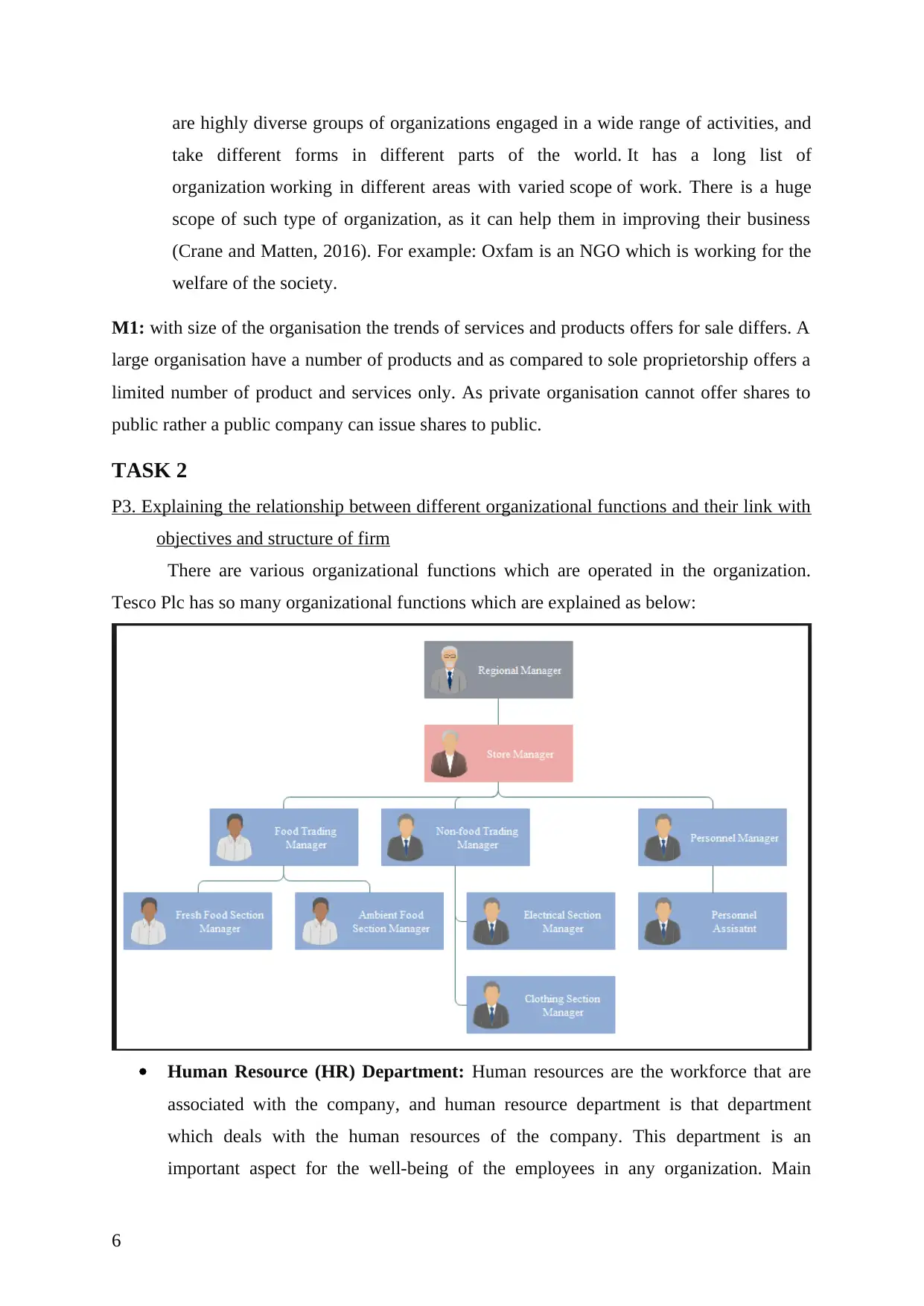
are highly diverse groups of organizations engaged in a wide range of activities, and
take different forms in different parts of the world. It has a long list of
organization working in different areas with varied scope of work. There is a huge
scope of such type of organization, as it can help them in improving their business
(Crane and Matten, 2016). For example: Oxfam is an NGO which is working for the
welfare of the society.
M1: with size of the organisation the trends of services and products offers for sale differs. A
large organisation have a number of products and as compared to sole proprietorship offers a
limited number of product and services only. As private organisation cannot offer shares to
public rather a public company can issue shares to public.
TASK 2
P3. Explaining the relationship between different organizational functions and their link with
objectives and structure of firm
There are various organizational functions which are operated in the organization.
Tesco Plc has so many organizational functions which are explained as below:
Human Resource (HR) Department: Human resources are the workforce that are
associated with the company, and human resource department is that department
which deals with the human resources of the company. This department is an
important aspect for the well-being of the employees in any organization. Main
6
take different forms in different parts of the world. It has a long list of
organization working in different areas with varied scope of work. There is a huge
scope of such type of organization, as it can help them in improving their business
(Crane and Matten, 2016). For example: Oxfam is an NGO which is working for the
welfare of the society.
M1: with size of the organisation the trends of services and products offers for sale differs. A
large organisation have a number of products and as compared to sole proprietorship offers a
limited number of product and services only. As private organisation cannot offer shares to
public rather a public company can issue shares to public.
TASK 2
P3. Explaining the relationship between different organizational functions and their link with
objectives and structure of firm
There are various organizational functions which are operated in the organization.
Tesco Plc has so many organizational functions which are explained as below:
Human Resource (HR) Department: Human resources are the workforce that are
associated with the company, and human resource department is that department
which deals with the human resources of the company. This department is an
important aspect for the well-being of the employees in any organization. Main
6
⊘ This is a preview!⊘
Do you want full access?
Subscribe today to unlock all pages.

Trusted by 1+ million students worldwide
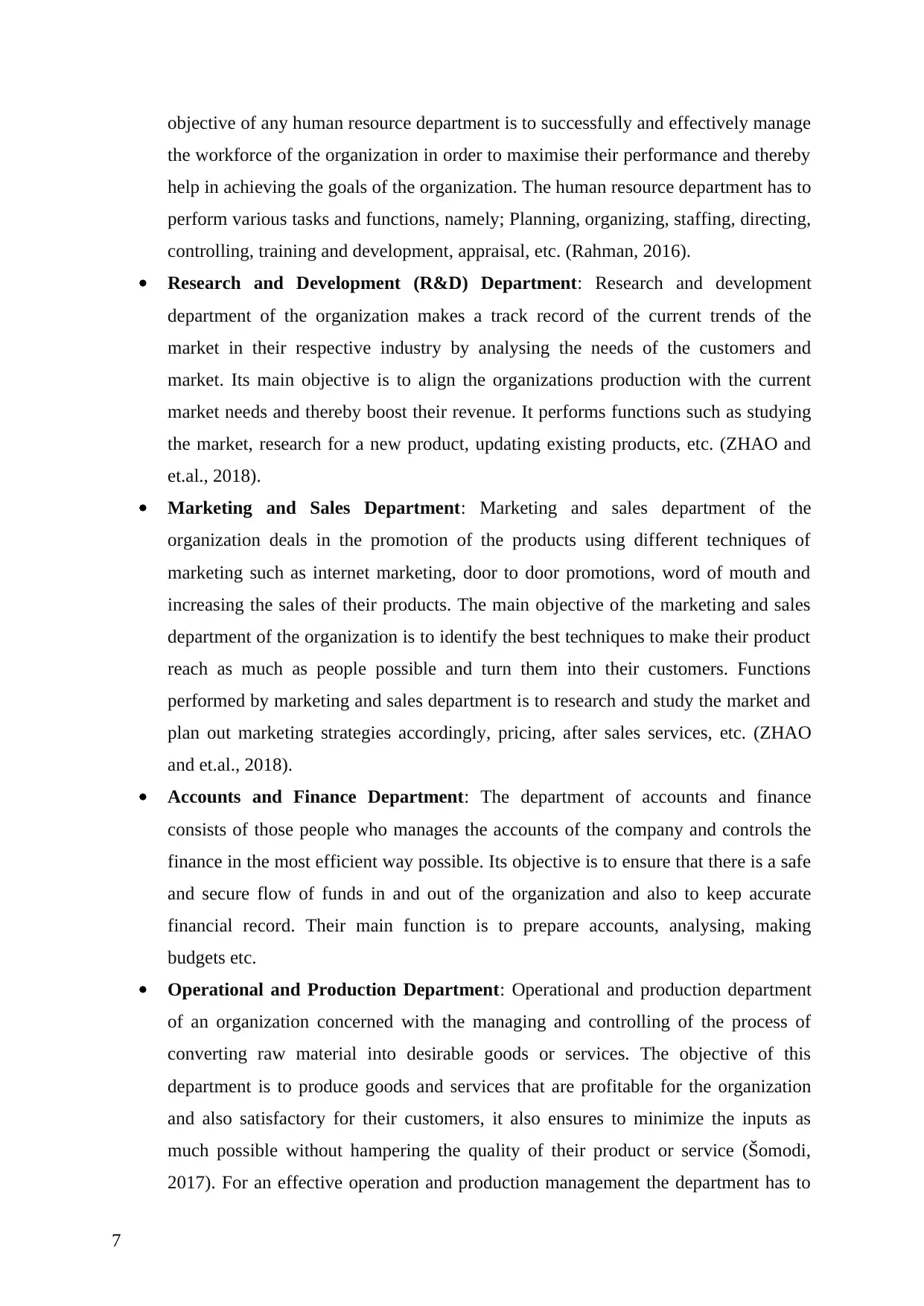
objective of any human resource department is to successfully and effectively manage
the workforce of the organization in order to maximise their performance and thereby
help in achieving the goals of the organization. The human resource department has to
perform various tasks and functions, namely; Planning, organizing, staffing, directing,
controlling, training and development, appraisal, etc. (Rahman, 2016).
Research and Development (R&D) Department: Research and development
department of the organization makes a track record of the current trends of the
market in their respective industry by analysing the needs of the customers and
market. Its main objective is to align the organizations production with the current
market needs and thereby boost their revenue. It performs functions such as studying
the market, research for a new product, updating existing products, etc. (ZHAO and
et.al., 2018).
Marketing and Sales Department: Marketing and sales department of the
organization deals in the promotion of the products using different techniques of
marketing such as internet marketing, door to door promotions, word of mouth and
increasing the sales of their products. The main objective of the marketing and sales
department of the organization is to identify the best techniques to make their product
reach as much as people possible and turn them into their customers. Functions
performed by marketing and sales department is to research and study the market and
plan out marketing strategies accordingly, pricing, after sales services, etc. (ZHAO
and et.al., 2018).
Accounts and Finance Department: The department of accounts and finance
consists of those people who manages the accounts of the company and controls the
finance in the most efficient way possible. Its objective is to ensure that there is a safe
and secure flow of funds in and out of the organization and also to keep accurate
financial record. Their main function is to prepare accounts, analysing, making
budgets etc.
Operational and Production Department: Operational and production department
of an organization concerned with the managing and controlling of the process of
converting raw material into desirable goods or services. The objective of this
department is to produce goods and services that are profitable for the organization
and also satisfactory for their customers, it also ensures to minimize the inputs as
much possible without hampering the quality of their product or service (Šomodi,
2017). For an effective operation and production management the department has to
7
the workforce of the organization in order to maximise their performance and thereby
help in achieving the goals of the organization. The human resource department has to
perform various tasks and functions, namely; Planning, organizing, staffing, directing,
controlling, training and development, appraisal, etc. (Rahman, 2016).
Research and Development (R&D) Department: Research and development
department of the organization makes a track record of the current trends of the
market in their respective industry by analysing the needs of the customers and
market. Its main objective is to align the organizations production with the current
market needs and thereby boost their revenue. It performs functions such as studying
the market, research for a new product, updating existing products, etc. (ZHAO and
et.al., 2018).
Marketing and Sales Department: Marketing and sales department of the
organization deals in the promotion of the products using different techniques of
marketing such as internet marketing, door to door promotions, word of mouth and
increasing the sales of their products. The main objective of the marketing and sales
department of the organization is to identify the best techniques to make their product
reach as much as people possible and turn them into their customers. Functions
performed by marketing and sales department is to research and study the market and
plan out marketing strategies accordingly, pricing, after sales services, etc. (ZHAO
and et.al., 2018).
Accounts and Finance Department: The department of accounts and finance
consists of those people who manages the accounts of the company and controls the
finance in the most efficient way possible. Its objective is to ensure that there is a safe
and secure flow of funds in and out of the organization and also to keep accurate
financial record. Their main function is to prepare accounts, analysing, making
budgets etc.
Operational and Production Department: Operational and production department
of an organization concerned with the managing and controlling of the process of
converting raw material into desirable goods or services. The objective of this
department is to produce goods and services that are profitable for the organization
and also satisfactory for their customers, it also ensures to minimize the inputs as
much possible without hampering the quality of their product or service (Šomodi,
2017). For an effective operation and production management the department has to
7
Paraphrase This Document
Need a fresh take? Get an instant paraphrase of this document with our AI Paraphraser
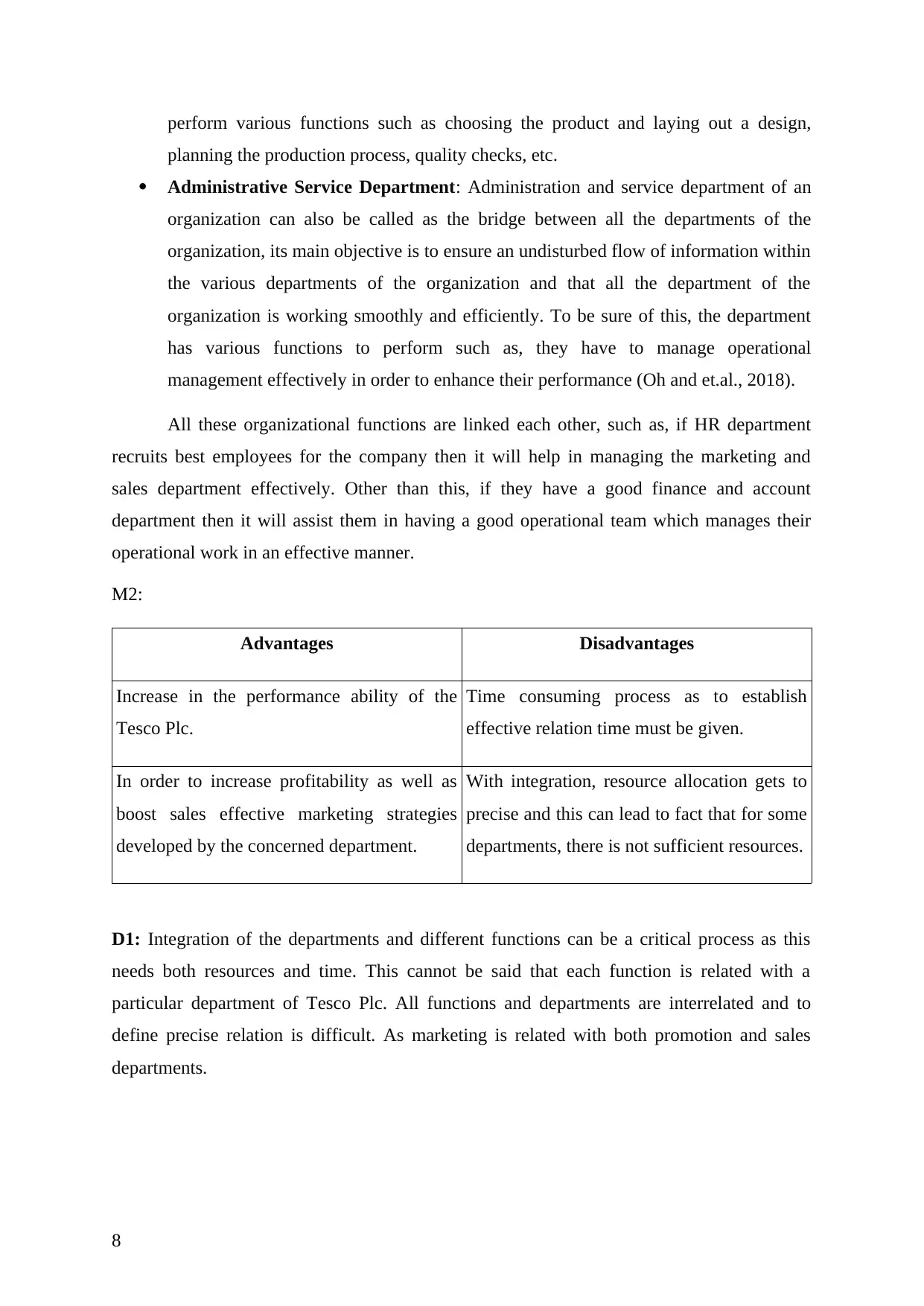
perform various functions such as choosing the product and laying out a design,
planning the production process, quality checks, etc.
Administrative Service Department: Administration and service department of an
organization can also be called as the bridge between all the departments of the
organization, its main objective is to ensure an undisturbed flow of information within
the various departments of the organization and that all the department of the
organization is working smoothly and efficiently. To be sure of this, the department
has various functions to perform such as, they have to manage operational
management effectively in order to enhance their performance (Oh and et.al., 2018).
All these organizational functions are linked each other, such as, if HR department
recruits best employees for the company then it will help in managing the marketing and
sales department effectively. Other than this, if they have a good finance and account
department then it will assist them in having a good operational team which manages their
operational work in an effective manner.
M2:
Advantages Disadvantages
Increase in the performance ability of the
Tesco Plc.
Time consuming process as to establish
effective relation time must be given.
In order to increase profitability as well as
boost sales effective marketing strategies
developed by the concerned department.
With integration, resource allocation gets to
precise and this can lead to fact that for some
departments, there is not sufficient resources.
D1: Integration of the departments and different functions can be a critical process as this
needs both resources and time. This cannot be said that each function is related with a
particular department of Tesco Plc. All functions and departments are interrelated and to
define precise relation is difficult. As marketing is related with both promotion and sales
departments.
8
planning the production process, quality checks, etc.
Administrative Service Department: Administration and service department of an
organization can also be called as the bridge between all the departments of the
organization, its main objective is to ensure an undisturbed flow of information within
the various departments of the organization and that all the department of the
organization is working smoothly and efficiently. To be sure of this, the department
has various functions to perform such as, they have to manage operational
management effectively in order to enhance their performance (Oh and et.al., 2018).
All these organizational functions are linked each other, such as, if HR department
recruits best employees for the company then it will help in managing the marketing and
sales department effectively. Other than this, if they have a good finance and account
department then it will assist them in having a good operational team which manages their
operational work in an effective manner.
M2:
Advantages Disadvantages
Increase in the performance ability of the
Tesco Plc.
Time consuming process as to establish
effective relation time must be given.
In order to increase profitability as well as
boost sales effective marketing strategies
developed by the concerned department.
With integration, resource allocation gets to
precise and this can lead to fact that for some
departments, there is not sufficient resources.
D1: Integration of the departments and different functions can be a critical process as this
needs both resources and time. This cannot be said that each function is related with a
particular department of Tesco Plc. All functions and departments are interrelated and to
define precise relation is difficult. As marketing is related with both promotion and sales
departments.
8
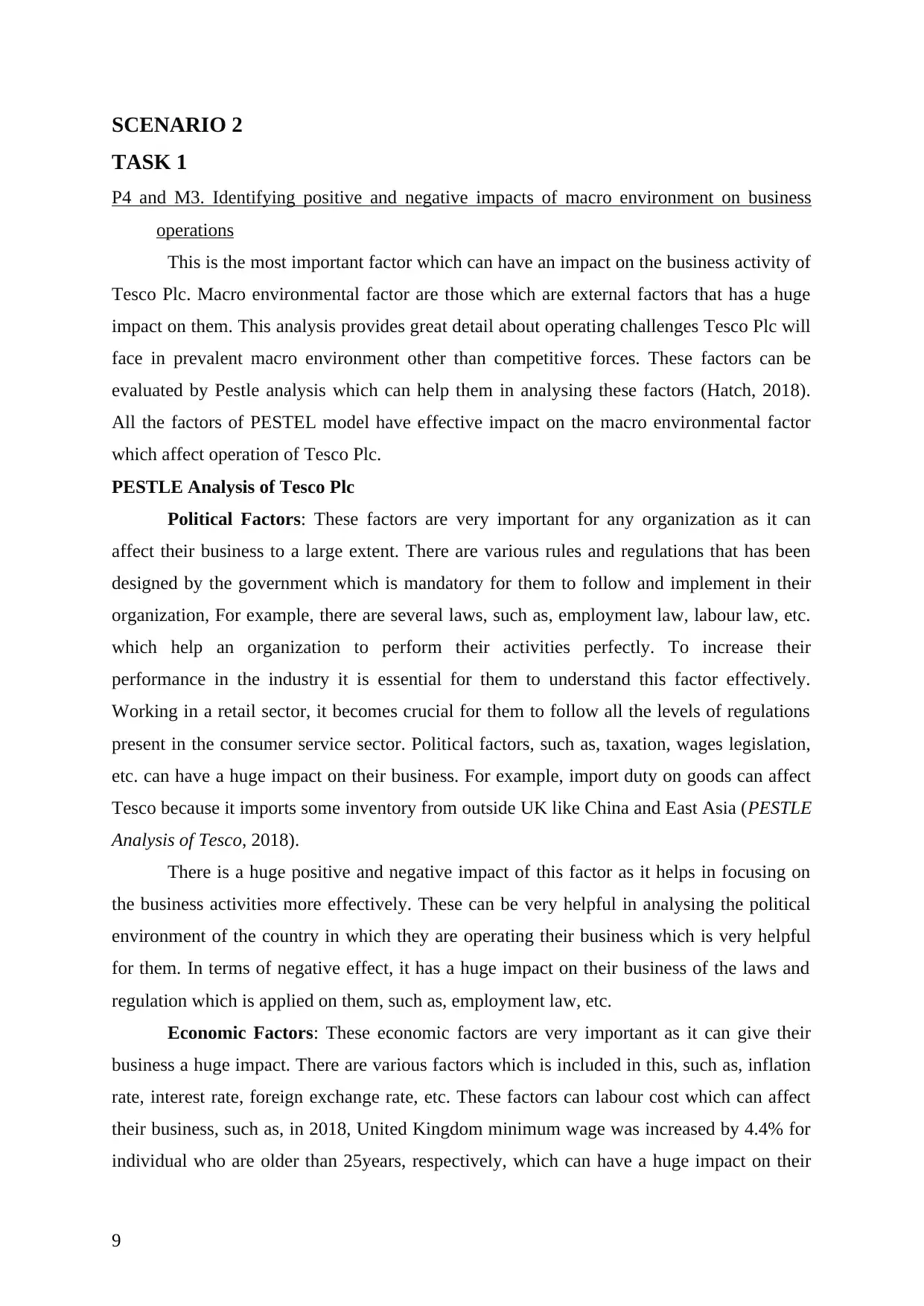
SCENARIO 2
TASK 1
P4 and M3. Identifying positive and negative impacts of macro environment on business
operations
This is the most important factor which can have an impact on the business activity of
Tesco Plc. Macro environmental factor are those which are external factors that has a huge
impact on them. This analysis provides great detail about operating challenges Tesco Plc will
face in prevalent macro environment other than competitive forces. These factors can be
evaluated by Pestle analysis which can help them in analysing these factors (Hatch, 2018).
All the factors of PESTEL model have effective impact on the macro environmental factor
which affect operation of Tesco Plc.
PESTLE Analysis of Tesco Plc
Political Factors: These factors are very important for any organization as it can
affect their business to a large extent. There are various rules and regulations that has been
designed by the government which is mandatory for them to follow and implement in their
organization, For example, there are several laws, such as, employment law, labour law, etc.
which help an organization to perform their activities perfectly. To increase their
performance in the industry it is essential for them to understand this factor effectively.
Working in a retail sector, it becomes crucial for them to follow all the levels of regulations
present in the consumer service sector. Political factors, such as, taxation, wages legislation,
etc. can have a huge impact on their business. For example, import duty on goods can affect
Tesco because it imports some inventory from outside UK like China and East Asia (PESTLE
Analysis of Tesco, 2018).
There is a huge positive and negative impact of this factor as it helps in focusing on
the business activities more effectively. These can be very helpful in analysing the political
environment of the country in which they are operating their business which is very helpful
for them. In terms of negative effect, it has a huge impact on their business of the laws and
regulation which is applied on them, such as, employment law, etc.
Economic Factors: These economic factors are very important as it can give their
business a huge impact. There are various factors which is included in this, such as, inflation
rate, interest rate, foreign exchange rate, etc. These factors can labour cost which can affect
their business, such as, in 2018, United Kingdom minimum wage was increased by 4.4% for
individual who are older than 25years, respectively, which can have a huge impact on their
9
TASK 1
P4 and M3. Identifying positive and negative impacts of macro environment on business
operations
This is the most important factor which can have an impact on the business activity of
Tesco Plc. Macro environmental factor are those which are external factors that has a huge
impact on them. This analysis provides great detail about operating challenges Tesco Plc will
face in prevalent macro environment other than competitive forces. These factors can be
evaluated by Pestle analysis which can help them in analysing these factors (Hatch, 2018).
All the factors of PESTEL model have effective impact on the macro environmental factor
which affect operation of Tesco Plc.
PESTLE Analysis of Tesco Plc
Political Factors: These factors are very important for any organization as it can
affect their business to a large extent. There are various rules and regulations that has been
designed by the government which is mandatory for them to follow and implement in their
organization, For example, there are several laws, such as, employment law, labour law, etc.
which help an organization to perform their activities perfectly. To increase their
performance in the industry it is essential for them to understand this factor effectively.
Working in a retail sector, it becomes crucial for them to follow all the levels of regulations
present in the consumer service sector. Political factors, such as, taxation, wages legislation,
etc. can have a huge impact on their business. For example, import duty on goods can affect
Tesco because it imports some inventory from outside UK like China and East Asia (PESTLE
Analysis of Tesco, 2018).
There is a huge positive and negative impact of this factor as it helps in focusing on
the business activities more effectively. These can be very helpful in analysing the political
environment of the country in which they are operating their business which is very helpful
for them. In terms of negative effect, it has a huge impact on their business of the laws and
regulation which is applied on them, such as, employment law, etc.
Economic Factors: These economic factors are very important as it can give their
business a huge impact. There are various factors which is included in this, such as, inflation
rate, interest rate, foreign exchange rate, etc. These factors can labour cost which can affect
their business, such as, in 2018, United Kingdom minimum wage was increased by 4.4% for
individual who are older than 25years, respectively, which can have a huge impact on their
9
⊘ This is a preview!⊘
Do you want full access?
Subscribe today to unlock all pages.

Trusted by 1+ million students worldwide
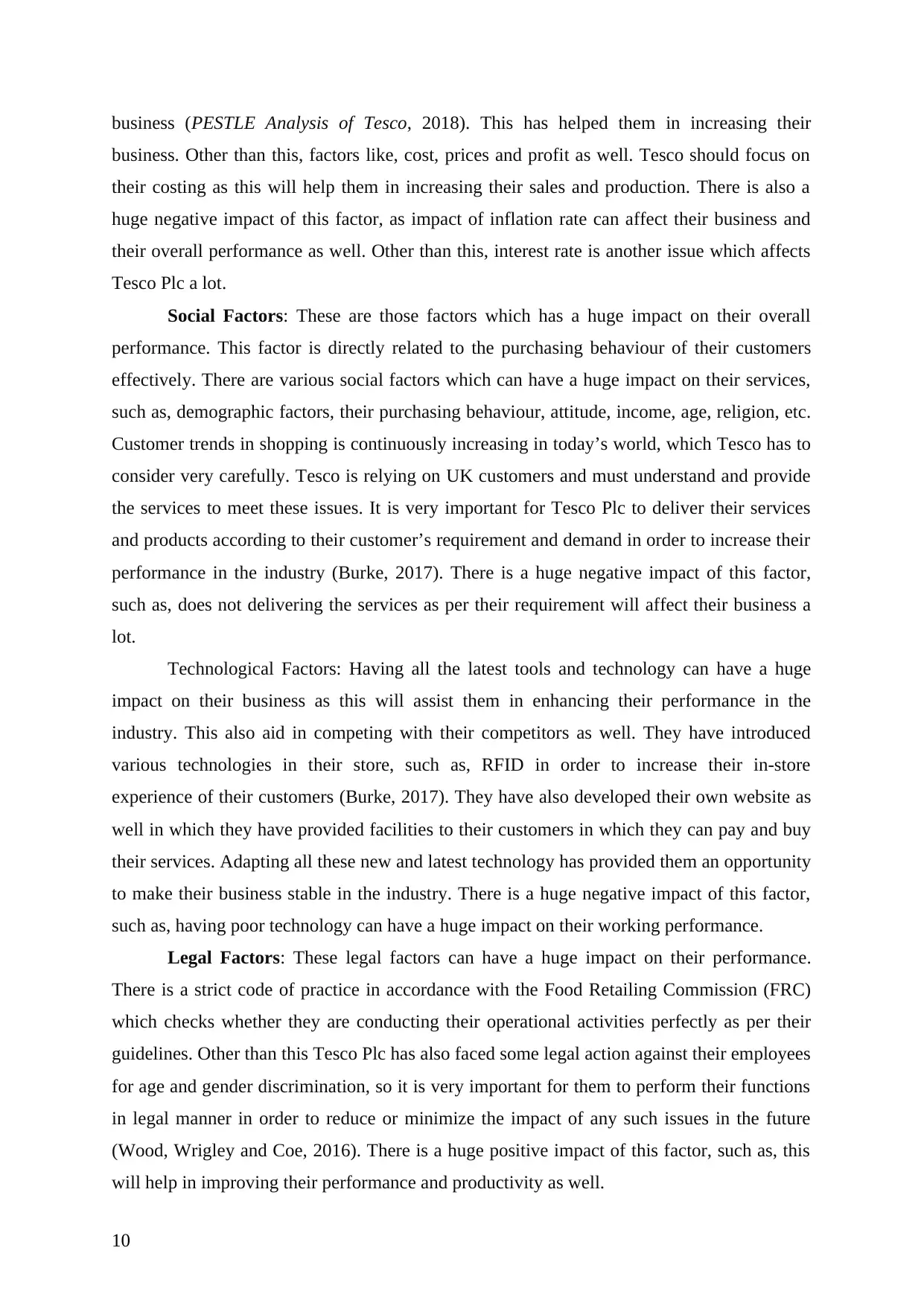
business (PESTLE Analysis of Tesco, 2018). This has helped them in increasing their
business. Other than this, factors like, cost, prices and profit as well. Tesco should focus on
their costing as this will help them in increasing their sales and production. There is also a
huge negative impact of this factor, as impact of inflation rate can affect their business and
their overall performance as well. Other than this, interest rate is another issue which affects
Tesco Plc a lot.
Social Factors: These are those factors which has a huge impact on their overall
performance. This factor is directly related to the purchasing behaviour of their customers
effectively. There are various social factors which can have a huge impact on their services,
such as, demographic factors, their purchasing behaviour, attitude, income, age, religion, etc.
Customer trends in shopping is continuously increasing in today’s world, which Tesco has to
consider very carefully. Tesco is relying on UK customers and must understand and provide
the services to meet these issues. It is very important for Tesco Plc to deliver their services
and products according to their customer’s requirement and demand in order to increase their
performance in the industry (Burke, 2017). There is a huge negative impact of this factor,
such as, does not delivering the services as per their requirement will affect their business a
lot.
Technological Factors: Having all the latest tools and technology can have a huge
impact on their business as this will assist them in enhancing their performance in the
industry. This also aid in competing with their competitors as well. They have introduced
various technologies in their store, such as, RFID in order to increase their in-store
experience of their customers (Burke, 2017). They have also developed their own website as
well in which they have provided facilities to their customers in which they can pay and buy
their services. Adapting all these new and latest technology has provided them an opportunity
to make their business stable in the industry. There is a huge negative impact of this factor,
such as, having poor technology can have a huge impact on their working performance.
Legal Factors: These legal factors can have a huge impact on their performance.
There is a strict code of practice in accordance with the Food Retailing Commission (FRC)
which checks whether they are conducting their operational activities perfectly as per their
guidelines. Other than this Tesco Plc has also faced some legal action against their employees
for age and gender discrimination, so it is very important for them to perform their functions
in legal manner in order to reduce or minimize the impact of any such issues in the future
(Wood, Wrigley and Coe, 2016). There is a huge positive impact of this factor, such as, this
will help in improving their performance and productivity as well.
10
business. Other than this, factors like, cost, prices and profit as well. Tesco should focus on
their costing as this will help them in increasing their sales and production. There is also a
huge negative impact of this factor, as impact of inflation rate can affect their business and
their overall performance as well. Other than this, interest rate is another issue which affects
Tesco Plc a lot.
Social Factors: These are those factors which has a huge impact on their overall
performance. This factor is directly related to the purchasing behaviour of their customers
effectively. There are various social factors which can have a huge impact on their services,
such as, demographic factors, their purchasing behaviour, attitude, income, age, religion, etc.
Customer trends in shopping is continuously increasing in today’s world, which Tesco has to
consider very carefully. Tesco is relying on UK customers and must understand and provide
the services to meet these issues. It is very important for Tesco Plc to deliver their services
and products according to their customer’s requirement and demand in order to increase their
performance in the industry (Burke, 2017). There is a huge negative impact of this factor,
such as, does not delivering the services as per their requirement will affect their business a
lot.
Technological Factors: Having all the latest tools and technology can have a huge
impact on their business as this will assist them in enhancing their performance in the
industry. This also aid in competing with their competitors as well. They have introduced
various technologies in their store, such as, RFID in order to increase their in-store
experience of their customers (Burke, 2017). They have also developed their own website as
well in which they have provided facilities to their customers in which they can pay and buy
their services. Adapting all these new and latest technology has provided them an opportunity
to make their business stable in the industry. There is a huge negative impact of this factor,
such as, having poor technology can have a huge impact on their working performance.
Legal Factors: These legal factors can have a huge impact on their performance.
There is a strict code of practice in accordance with the Food Retailing Commission (FRC)
which checks whether they are conducting their operational activities perfectly as per their
guidelines. Other than this Tesco Plc has also faced some legal action against their employees
for age and gender discrimination, so it is very important for them to perform their functions
in legal manner in order to reduce or minimize the impact of any such issues in the future
(Wood, Wrigley and Coe, 2016). There is a huge positive impact of this factor, such as, this
will help in improving their performance and productivity as well.
10
Paraphrase This Document
Need a fresh take? Get an instant paraphrase of this document with our AI Paraphraser
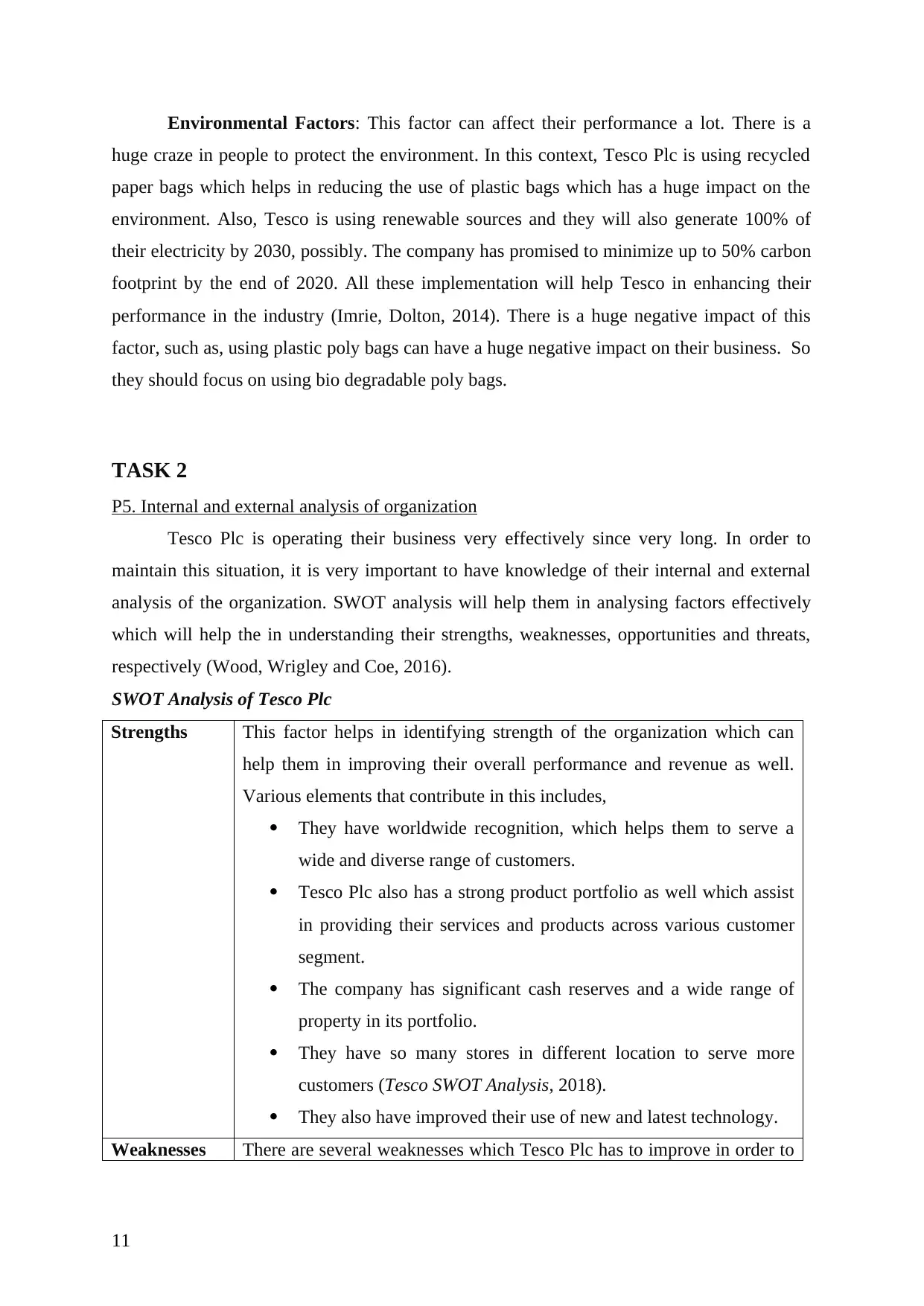
Environmental Factors: This factor can affect their performance a lot. There is a
huge craze in people to protect the environment. In this context, Tesco Plc is using recycled
paper bags which helps in reducing the use of plastic bags which has a huge impact on the
environment. Also, Tesco is using renewable sources and they will also generate 100% of
their electricity by 2030, possibly. The company has promised to minimize up to 50% carbon
footprint by the end of 2020. All these implementation will help Tesco in enhancing their
performance in the industry (Imrie, Dolton, 2014). There is a huge negative impact of this
factor, such as, using plastic poly bags can have a huge negative impact on their business. So
they should focus on using bio degradable poly bags.
TASK 2
P5. Internal and external analysis of organization
Tesco Plc is operating their business very effectively since very long. In order to
maintain this situation, it is very important to have knowledge of their internal and external
analysis of the organization. SWOT analysis will help them in analysing factors effectively
which will help the in understanding their strengths, weaknesses, opportunities and threats,
respectively (Wood, Wrigley and Coe, 2016).
SWOT Analysis of Tesco Plc
Strengths This factor helps in identifying strength of the organization which can
help them in improving their overall performance and revenue as well.
Various elements that contribute in this includes,
They have worldwide recognition, which helps them to serve a
wide and diverse range of customers.
Tesco Plc also has a strong product portfolio as well which assist
in providing their services and products across various customer
segment.
The company has significant cash reserves and a wide range of
property in its portfolio.
They have so many stores in different location to serve more
customers (Tesco SWOT Analysis, 2018).
They also have improved their use of new and latest technology.
Weaknesses There are several weaknesses which Tesco Plc has to improve in order to
11
huge craze in people to protect the environment. In this context, Tesco Plc is using recycled
paper bags which helps in reducing the use of plastic bags which has a huge impact on the
environment. Also, Tesco is using renewable sources and they will also generate 100% of
their electricity by 2030, possibly. The company has promised to minimize up to 50% carbon
footprint by the end of 2020. All these implementation will help Tesco in enhancing their
performance in the industry (Imrie, Dolton, 2014). There is a huge negative impact of this
factor, such as, using plastic poly bags can have a huge negative impact on their business. So
they should focus on using bio degradable poly bags.
TASK 2
P5. Internal and external analysis of organization
Tesco Plc is operating their business very effectively since very long. In order to
maintain this situation, it is very important to have knowledge of their internal and external
analysis of the organization. SWOT analysis will help them in analysing factors effectively
which will help the in understanding their strengths, weaknesses, opportunities and threats,
respectively (Wood, Wrigley and Coe, 2016).
SWOT Analysis of Tesco Plc
Strengths This factor helps in identifying strength of the organization which can
help them in improving their overall performance and revenue as well.
Various elements that contribute in this includes,
They have worldwide recognition, which helps them to serve a
wide and diverse range of customers.
Tesco Plc also has a strong product portfolio as well which assist
in providing their services and products across various customer
segment.
The company has significant cash reserves and a wide range of
property in its portfolio.
They have so many stores in different location to serve more
customers (Tesco SWOT Analysis, 2018).
They also have improved their use of new and latest technology.
Weaknesses There are several weaknesses which Tesco Plc has to improve in order to
11
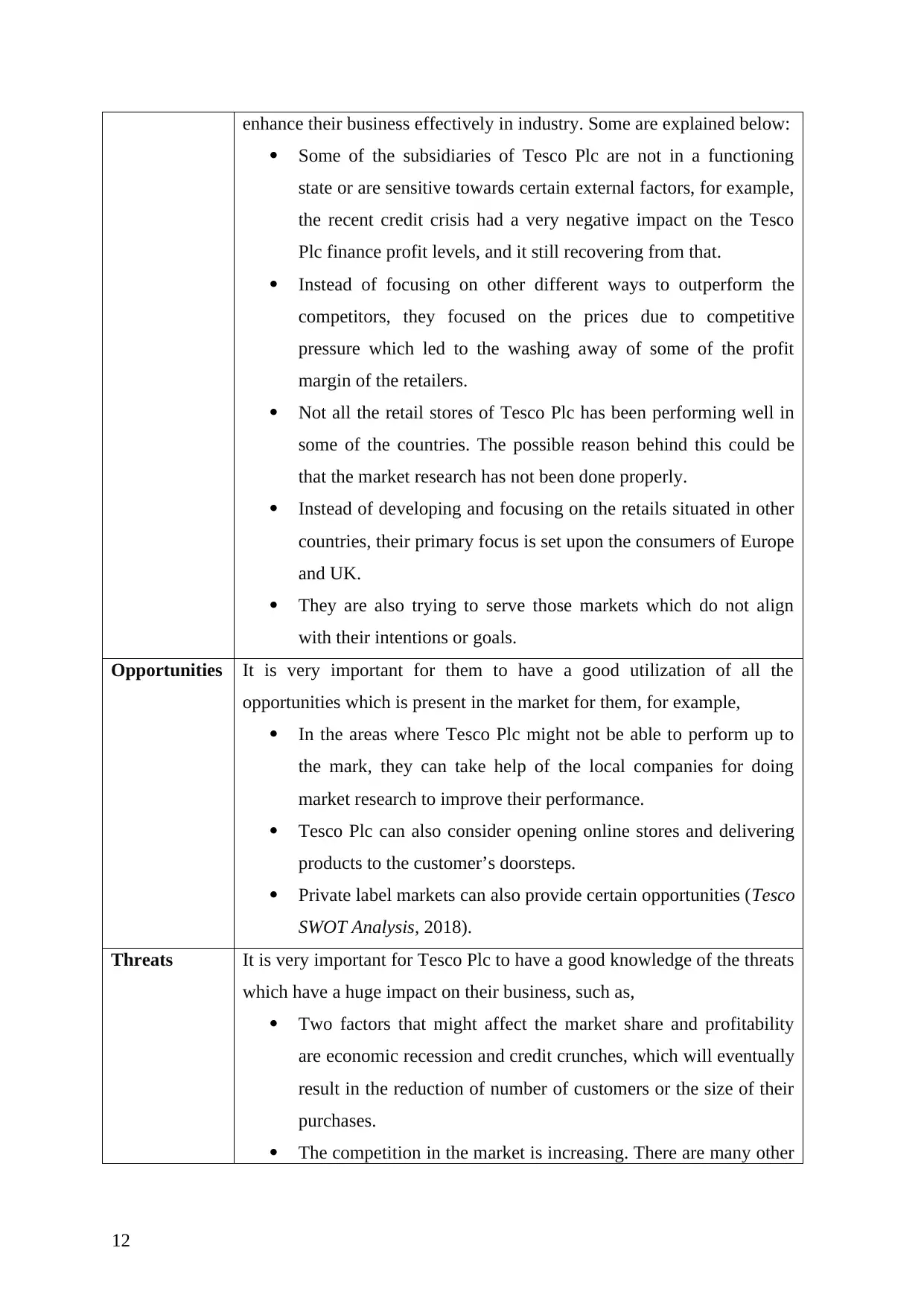
enhance their business effectively in industry. Some are explained below:
Some of the subsidiaries of Tesco Plc are not in a functioning
state or are sensitive towards certain external factors, for example,
the recent credit crisis had a very negative impact on the Tesco
Plc finance profit levels, and it still recovering from that.
Instead of focusing on other different ways to outperform the
competitors, they focused on the prices due to competitive
pressure which led to the washing away of some of the profit
margin of the retailers.
Not all the retail stores of Tesco Plc has been performing well in
some of the countries. The possible reason behind this could be
that the market research has not been done properly.
Instead of developing and focusing on the retails situated in other
countries, their primary focus is set upon the consumers of Europe
and UK.
They are also trying to serve those markets which do not align
with their intentions or goals.
Opportunities It is very important for them to have a good utilization of all the
opportunities which is present in the market for them, for example,
In the areas where Tesco Plc might not be able to perform up to
the mark, they can take help of the local companies for doing
market research to improve their performance.
Tesco Plc can also consider opening online stores and delivering
products to the customer’s doorsteps.
Private label markets can also provide certain opportunities (Tesco
SWOT Analysis, 2018).
Threats It is very important for Tesco Plc to have a good knowledge of the threats
which have a huge impact on their business, such as,
Two factors that might affect the market share and profitability
are economic recession and credit crunches, which will eventually
result in the reduction of number of customers or the size of their
purchases.
The competition in the market is increasing. There are many other
12
Some of the subsidiaries of Tesco Plc are not in a functioning
state or are sensitive towards certain external factors, for example,
the recent credit crisis had a very negative impact on the Tesco
Plc finance profit levels, and it still recovering from that.
Instead of focusing on other different ways to outperform the
competitors, they focused on the prices due to competitive
pressure which led to the washing away of some of the profit
margin of the retailers.
Not all the retail stores of Tesco Plc has been performing well in
some of the countries. The possible reason behind this could be
that the market research has not been done properly.
Instead of developing and focusing on the retails situated in other
countries, their primary focus is set upon the consumers of Europe
and UK.
They are also trying to serve those markets which do not align
with their intentions or goals.
Opportunities It is very important for them to have a good utilization of all the
opportunities which is present in the market for them, for example,
In the areas where Tesco Plc might not be able to perform up to
the mark, they can take help of the local companies for doing
market research to improve their performance.
Tesco Plc can also consider opening online stores and delivering
products to the customer’s doorsteps.
Private label markets can also provide certain opportunities (Tesco
SWOT Analysis, 2018).
Threats It is very important for Tesco Plc to have a good knowledge of the threats
which have a huge impact on their business, such as,
Two factors that might affect the market share and profitability
are economic recession and credit crunches, which will eventually
result in the reduction of number of customers or the size of their
purchases.
The competition in the market is increasing. There are many other
12
⊘ This is a preview!⊘
Do you want full access?
Subscribe today to unlock all pages.

Trusted by 1+ million students worldwide
1 out of 17
Related Documents
Your All-in-One AI-Powered Toolkit for Academic Success.
+13062052269
info@desklib.com
Available 24*7 on WhatsApp / Email
![[object Object]](/_next/static/media/star-bottom.7253800d.svg)
Unlock your academic potential
Copyright © 2020–2025 A2Z Services. All Rights Reserved. Developed and managed by ZUCOL.





